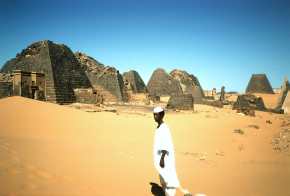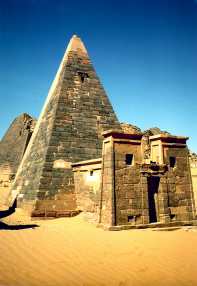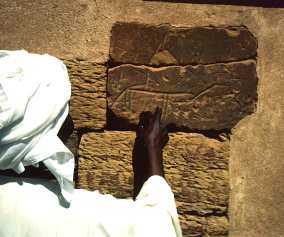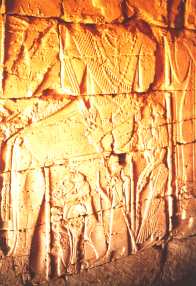On the way from Khartoum to Port Sudan, about 200 km north-east of Khartoum,
near Bagrawiya, the traveller passes by the area of the ancient Meroë,
where he can find a group of
a few dozens of pyramids spread over a small hill about
one quarter square kilometer in size. The pyramids, much smaller than their
well-known counterparts in Egypt, are the remains of a royal cemetery
from the Meroitic kingdom (between 300 B.C. and 300 A.D.).
|

|
Ancient approach
The region of the Nile Valley which lies in the northern part
of the present Sudan, has been influenced by the Egyptian
civilization since the time of the Ancient Egyptian Kingdom.
This influence grew stronger during the occupation by Egypt
in the period of the Middle Kingdom and reached its summit
after the Egyptians conquered the whole region up to the 4th
Nile Cataract.
|
The Egyptian colonization lasted for almost
five centuries and came to an end when in the twelfth century B.C.
the Egyptian Empire fell into pieces.
|
4oo years later it were the kings of Napata in northern Sudan
who ruled the Nile Valley from the Blue Nile down to the Delta.
They revived the burial customs of the pyramid many centuries
after the Pharaos had stopped building them and employed Egyptian
artists in their architectural works. While the Napatan kingdom
had to give up Egypt in 661 B.C. and subsequently the Egyptian
influence started to decline, the burial traditions still survived
and, after the the transfer of the kingship to the
Meroitic line in the third century B.C., were taken over by the
kings of Meroë.
|

|

|
Present approach
Excavations at Bagrawiya started in the 19th century, when the Europeans
made their first archaeological expeditions into Nubia. When the
British took control over Sudan in its new boundaries, part of the
treasury had already been brought to Paris, Munich and Berlin. As most
of the remains was left unprotected at that time,
it experienced severe damage by the steady
action of winds and dust storms over the decades of this century.
|
Today the most urgent preservation work is done by a small group of
specialists under the leading of F.W.Hinkel, a German Architect and Archaeologist,
supported by the Sudanese government and some international aid.
Related links:
Meroë Pyramids.
Sudan Archaeological Society in Berlin,
focussing its work on the site of Musawwarat As-Sufra.
Ancient Nubia,
an exhibition.
Ancient Kingdoms in Sudan,
an exhibition (in German).
|

|



